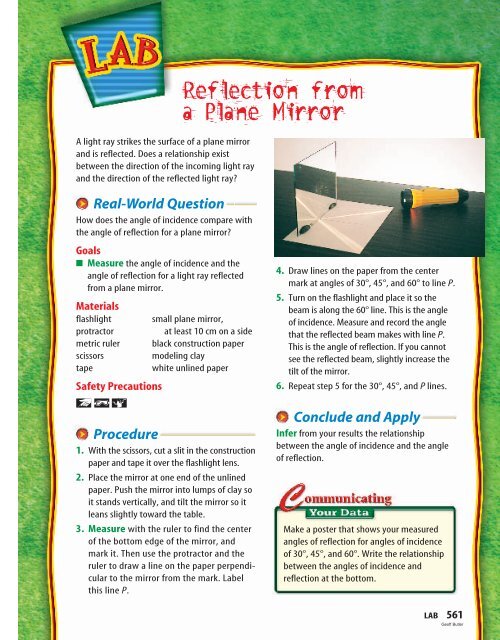Light Mirrors and Lenses (3379.0K) - McGraw-Hill Higher Education
Light Mirrors and Lenses (3379.0K) - McGraw-Hill Higher Education
Light Mirrors and Lenses (3379.0K) - McGraw-Hill Higher Education
- No tags were found...
You also want an ePaper? Increase the reach of your titles
YUMPU automatically turns print PDFs into web optimized ePapers that Google loves.
A light ray strikes the surface of a plane mirror<strong>and</strong> is reflected. Does a relationship existbetween the direction of the incoming light ray<strong>and</strong> the direction of the reflected light ray?Reflection froma Plane MirrorReal-World QuestionHow does the angle of incidence compare withthe angle of reflection for a plane mirror?Goals■ Measure the angle of incidence <strong>and</strong> theangle of reflection for a light ray reflectedfrom a plane mirror.Materialsflashlightprotractormetric rulerscissorstapeSafety Precautionssmall plane mirror,at least 10 cm on a sideblack construction papermodeling claywhite unlined paperProcedure1. With the scissors, cut a slit in the constructionpaper <strong>and</strong> tape it over the flashlight lens.2. Place the mirror at one end of the unlinedpaper. Push the mirror into lumps of clay soit st<strong>and</strong>s vertically, <strong>and</strong> tilt the mirror so itleans slightly toward the table.3. Measure with the ruler to find the centerof the bottom edge of the mirror, <strong>and</strong>mark it. Then use the protractor <strong>and</strong> theruler to draw a line on the paper perpendicularto the mirror from the mark. Labelthis line P.4. Draw lines on the paper from the centermark at angles of 30°, 45°, <strong>and</strong> 60° to line P.5. Turn on the flashlight <strong>and</strong> place it so thebeam is along the 60° line. This is the angleof incidence. Measure <strong>and</strong> record the anglethat the reflected beam makes with line P.This is the angle of reflection. If you cannotsee the reflected beam, slightly increase thetilt of the mirror.6. Repeat step 5 for the 30°, 45°, <strong>and</strong> P lines.Conclude <strong>and</strong> ApplyInfer from your results the relationshipbetween the angle of incidence <strong>and</strong> the angleof reflection.Make a poster that shows your measuredangles of reflection for angles of incidenceof 30°, 45°, <strong>and</strong> 60°. Write the relationshipbetween the angles of incidence <strong>and</strong>reflection at the bottom.LAB 561Geoff Butler

















